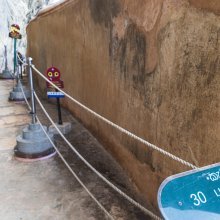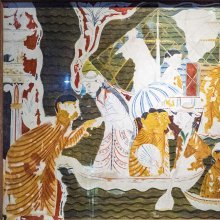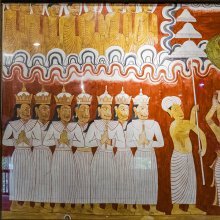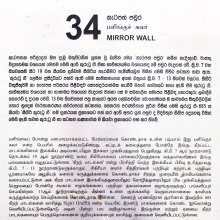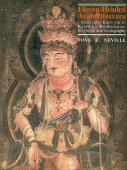Wall painting: 1 definition
Introduction:
Wall painting means something in the history of ancient India. If you want to know the exact meaning, history, etymology or English translation of this term then check out the descriptions on this page. Add your comment or reference to a book if you want to contribute to this summary article.
Images (photo gallery)
India history and geography
Source: Singhi Jain Series: Ratnaprabha-suri’s Kuvalayamala-katha (history)Wall paintings of in ancient India (e.g., Ajanta and Ellora) were painted using colours extracted from minerals, according to the rules of Citrasūtra and the Kathās (narrative poems) such as Uddyotanasūri in his 8th-century Kuvalayamālā (a Prakrit Campū, similar to Kāvya poetry).—Page 249:19: There is a reference to mineral colours used in painting and made from the powder of stones of different colours. Such mineral colours were used in the wall paintings of Ajanta and also at Ellora during the 8th century. Perhaps Uddyotanasūri was working on facts as had reached his ears. There actually was in the erstwhile state of Shakti in Madhyapradesh a place named Ṛṣabhapura which is mentioned in the Āraṇyakaparvan as a place of pilgrimage and visited by many persons to which the Pāṇḍavas also went with their teacher. It is probable that the place was notorious for its Kāpālika practices.

The history of India traces the identification of countries, villages, towns and other regions of India, as well as mythology, zoology, royal dynasties, rulers, tribes, local festivities and traditions and regional languages. Ancient India enjoyed religious freedom and encourages the path of Dharma, a concept common to Buddhism, Hinduism, and Jainism.
See also (Relevant definitions)
Partial matches: Painting, Wall.
Full-text: Bhitti-citra, Nayaka, Vishvadaka, Rishabhapura, Mineral, Powder, Majala, Bhumibandha.
Relevant text
Search found 4 books and stories containing Wall painting; (plurals include: Wall paintings). You can also click to the full overview containing English textual excerpts. Below are direct links for the most relevant articles:
Vishnudharmottara Purana (Art and Architecture) (by Bhagyashree Sarma)
5. The Viṣṇudharmottara-purāṇa and the Modern Paintings < [Chapter 6 - Modern Relevance of Different Art Forms and Architecture]
Folk-Art in India < [April – June, July – September 1978]
Folk-Art in India < [January, 1928]
Buddhist China and South India < [October – December, 1988]
Amaravati Art in the Context of Andhra Archaeology (by Sreyashi Ray chowdhuri)
Amarāvatī impact on later schools of Indian art < [Chapter 5 - Impact of Amarāvatī Art]
Artistic Connectivity between Amarāvatī and Sri Lanka < [Chapter 5 - Impact of Amarāvatī Art]
The Great Buddhist Emperors of Asia (by Shibani Dutta)
Related products
